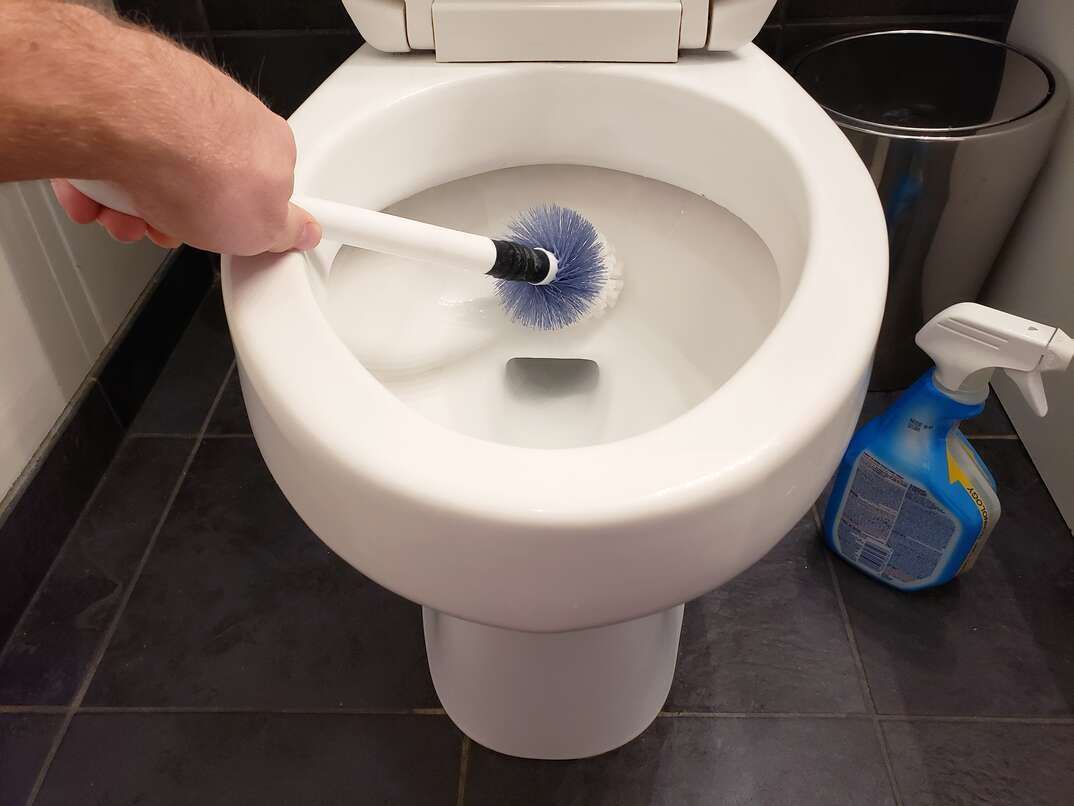How to Properly Clean Your Toilet

No one wants to be on toilet-cleaning duty, but someone has to grab the brush and scrub.
This May Also Interest You: 3 Reasons Your Toilet Is Running — and How to Fix It
While cleaning a toilet isn't difficult, it can be messy, and there are a few things you should avoid to prevent damage.
What Products Should You Use to Clean a Toilet?
You can use a variety of cleaning products on your toilet. Look for products labeled specifically for use in toilets or bathrooms. Toilet-bowl cleaner helps remove gunk and germs inside the toilet bowl. For the outside surfaces, a general-purpose bathroom cleaner works well.
When deciding how to clean a toilet, you might prefer a product you’ve already got in your pantry. Traditional bathroom cleaners can contain chemicals that have harsh odors that aren't good to inhale. Vinegar is a natural alternative that you can use in the toilet bowl and on the exterior toilet surfaces. For an easy cleaning solution, combine equal parts of white vinegar and water in a spray bottle and use it like a commercial cleaner.
Step-by-Step: How to Clean Your Toilet
Everyone has their own method of cleaning, but these steps will help you clean your toilet well. You have some choice in the cleaners and tools you use for cleaning. Follow these steps for how to clean a toilet:
Step 1: Prep the Area
Remove everything off the top of the toilet, and remove items from around the toilet, such as rugs. If you have a fabric toilet seat cover, remove that as well. Tossing it and the rugs in the washing machine while you clean the toilet helps freshen them up as well. Grab your cleaning supplies and put on some gloves before you start.
Step 2: Apply the Toilet Bowl Cleaner
Start by putting your selected cleaner in the toilet bowl. If you're using vinegar, pour about one cup into the bowl. Then, spray some vinegar on the upper portion of the bowl above the water line. If you're using traditional toilet bowl cleaner, squirt a generous amount along the inner rim, so it drips down the sides of the toilet bowl. Don't combine vinegar with traditional toilet bowl cleaner because the ingredients can have dangerous interactions. Let the cleaner sit while you move on to the next step.
Step 3: Wipe Down the Exterior
Move on to the exterior of the toilet while the bowl cleaner gets to work. Start at the highest point on the toilet and work down to the ground to avoid having cleaner drip on surfaces you've already cleaned. Spray your selected cleaner on the various surfaces and wipe it clean. Areas to clean include:
- Tank lid
- Tank sides
- Flush handle
- Toilet seat lid
- Top and bottom of the toilet seat
- Top edge of the toilet bowl
- Sides of the toilet bowl
Don't forget to wipe along the bottom edge where the toilet meets the floor. Dirt and gunk often build up in that gap.
Step 4: Scrub Inside the Bowl
Grab your toilet bowl brush and scrub the inside of the bowl, starting around the top rim. Work down the sides, and brush all surfaces inside the toilet bowl. Spend more time on areas that are visibly dirty. Move the brush down to the bottom of the toilet bowl. Flush the toilet to wash away the cleaner. Check for any remaining spots and brush again as needed.
More Related Articles:
- Condensation on Your Toilet? Don’t Sweat It
- How to Fix Your Toilet Handle in 6 Simple Steps
- What’ll a New Toilet Do to Your Bottom Line? Here’s What It Costs
- Time to Swap Seats? Here’s How to Install or Replace a Toilet Seat
- Never Flush These 11 Things Down Your Toilet
Cleaning a Toilet: 3 Things to Avoid
While toilets are very durable, they can become damaged, and some chemicals are dangerous to use. It's always better to start with the gentlest cleaning options and move to stronger things if needed to protect yourself and your bathroom surfaces.
Avoid these common cleaning techniques:
Bleach
Never use bleach in the tank as it can damage the internal parts. It's usually okay to use in the bowl, but it can be hazardous to you if you don't use it correctly. Other cleaning products work just as well with fewer risks.
Combining Cleaners
Cleaners have a variety of ingredients in them, and many combinations are dangerous. Bleach shouldn't be combined with anything else — it reacts with many other cleaners and creates a toxic gas. Vinegar and ammonia are two common cleaners that can create a dangerous gas when combined with bleach. Avoid the problem by only using one type of cleaner.
Abrasive Cleaning Tools
Harsh tools, such as wire-bristled brushes, can scratch the toilet surface and leave permanent marks. Use nylon-bristled brushes instead. Be aware of metal pieces on any cleaning tools that might touch the toilet surface.


